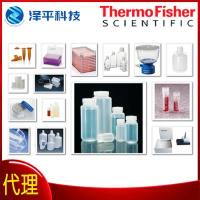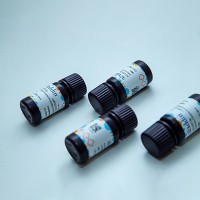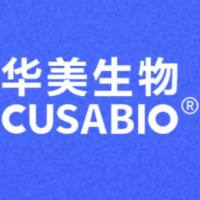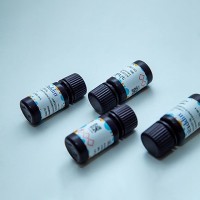Synthesis of Building Blocks and Oligonucleotides with {G}O6‐Alkyl‐O6{G} Cross‐Links
互联网
- Abstract
- Table of Contents
- Materials
- Figures
- Literature Cited
Abstract
This unit describes two methods for preparing oligonucleotides containing an O6 ?2??deoxyguanosine?alkyl?O6 ?2??deoxyguanosine interstrand cross?link by a solid?phase synthesis approach. Depending on the desired orientation of the cross?link in the DNA duplex, either a bis? or a mono?phosphoramidite synthesis strategy can be employed. Both procedures require the preparation of a protected 2??deoxyguanosine?containing dimer where the two nucleosides are attached at the O6 ?atoms by an alkyl linker. This linker is introduced as a protected diol using two successive Mitsunobu reactions to produce a cross?linked amidite that is incorporated into an oligonucleotide via solid?phase synthesis. The use of a protected diol lends versatility to this method, as cross?links of variable chain length may be prepared. The bis?phosphoramidite approach is a direct method to preparing the cross?linked duplex, whereas the mono?phosphoramidite strategy requires additional manipulation of the solid support to prepare cross?linked oligonucleotides. Once all synthetic steps are completed, these oligonucleotides can then be removed from the solid support and deprotected, and then purified via ion?exchange HPLC to produce sufficient quantities of substrates that can be used in DNA repair studies. Curr. Protoc. Nucleic Acid Chem. 44:5.9.1?5.9.19. © 2011 by John Wiley & Sons, Inc.
Keywords: interstrand cross?link; phosphoramidite; oligonucleotide synthesis; chemical synthesis; solid?phase synthesis; DNA repair
Table of Contents
- Introduction
- Basic Protocol 1: Protection of the Diol with a tert‐Butyldiphenyl Silyl Group
- Basic Protocol 2: Synthesis of O6‐2′‐Deoxyguanosine‐Alkyl‐O6‐2′‐Deoxyguanosine‐3′‐O‐bis‐Phosphoramidites
- Basic Protocol 3: Synthesis of 1‐{O6‐[3′‐O‐tert‐Butyldimethysilyl‐5′‐O‐Dimethoxytrityl‐N2‐Phenoxyacetyl‐2′‐Deoxyguanidyl]}‐7‐{O6‐[5′‐O‐Dimethoxytrityl‐N2‐Phenoxyacetyl‐2′‐Deoxyguanidyl‐3′‐O‐(β‐2‐Cyanoethyl‐N,N′‐Diisopropyl)Phosphoramidite]}‐Heptane
- Basic Protocol 4: Solid‐Phase Synthesis and Deprotection of O6‐2′‐Deoxyguanosine‐Alkyl‐O6‐2′‐Deoxyguanosine Oligonucleotides
- Commentary
- Literature Cited
- Figures
Materials
Basic Protocol 1: Protection of the Diol with a tert‐Butyldiphenyl Silyl Group
Materials
Basic Protocol 2: Synthesis of O6‐2′‐Deoxyguanosine‐Alkyl‐O6‐2′‐Deoxyguanosine‐3′‐O‐bis‐Phosphoramidites
Materials
Basic Protocol 3: Synthesis of 1‐{O6‐[3′‐O‐tert‐Butyldimethysilyl‐5′‐O‐Dimethoxytrityl‐N2‐Phenoxyacetyl‐2′‐Deoxyguanidyl]}‐7‐{O6‐[5′‐O‐Dimethoxytrityl‐N2‐Phenoxyacetyl‐2′‐Deoxyguanidyl‐3′‐O‐(β‐2‐Cyanoethyl‐N,N′‐Diisopropyl)Phosphoramidite]}‐Heptane
Materials
Basic Protocol 4: Solid‐Phase Synthesis and Deprotection of O6‐2′‐Deoxyguanosine‐Alkyl‐O6‐2′‐Deoxyguanosine Oligonucleotides
Materials
|
Figures
-
Figure 5.9.1 Chemical structure of the O6 ‐2′‐deoxyguanosine‐alkyl‐O6 ‐2′‐deoxyguanosine cross‐link. View Image -
Figure 5.9.2 Preparation of mono‐ tert ‐butyldiphenylsilylated diols (S.1 and S.2 ). Abbreviations: TBDPS‐Cl, tert‐butyldiphenylsilyl; THF, tetrahydrofuran. View Image -
Figure 5.9.3 Preparation of S.7 . (a) S.1 , triphenylphosphine, DIAD, 1,4‐dioxane; (b) TBAF, THF; (c) triphenylphosphine, DIAD, 1,4‐dioxane; (d) triphenylphosphine, Pd(Ph3 P)4 , formic acid, butylamine, 1,4‐dioxane; (e) Cl‐P(OCE)N i Pr2, DIPEA, THF. Abbreviations: DIAD, diisopropylazodicarboxylate; TBAF, tetrabutylammonium fluoride; Pd(Ph3 P)4 , palladium (0) tetrakistriphenylphosphine; Cl‐P(OCE)N i Pr2 , N , N ‐diisopropylamino cyanoethyl phosphonamidic chloride; DIPEA, diisopropylethylamine; DMT, dimethoxytrityl; Alloc, allyloxycarbonyl; Pac, phenoxyacetyl; TBDPS, tert ‐butyldiphenylsilyl; THF, tetrahydrofuran. View Image -
Figure 5.9.4 Synthesis of S.12 . (a) S.2 , triphenylphosphine, DIAD, 1,4‐dioxane; (b) TBAF, THF; (c) triphenylphosphine, DIAD, 1,4‐dioxane; (d) triphenylphosphine, Pd(Ph3 P)4 , formic acid, butylamine, 1,4‐dioxane; (e) Cl‐P(OCE)N i Pr2, DIPEA, THF. Abbreviations: DIAD, diisopropylazodicarboxylate; TBAF, tetrabutylammonium fluoride; Pd(Ph3 P)4 , palladium (0) tetrakistriphenylphosphine; Cl‐P(OCE)N i Pr2 , N , N ‐diisopropylamino cyanoethyl phosphonamidic chloride; DIPEA, diisopropylethylamine; DMT, dimethoxytrityl; Alloc, allyloxycarbonyl; Pac, phenoxyacetyl; TBDPS, tert ‐butyldiphenylsilyl; TBS, tert ‐butyldimethylsilyl; THF, tetrahydrofuran. View Image -
Figure 5.9.5 Bis‐phosphoramidite approach for assembly of oligonucleotides containing an O6 ‐2′‐deoxyguanosine‐alkyl‐O6 ‐2′‐deoxyguanosine cross‐link by solid‐phase synthesis. (a) Oligonucleotide synthesis with 2′‐deoxyribonucleoside 3′‐phosphoramidites; (b) coupling with bis‐phosphoramidite S.7 ; (c) chain extension with 2′‐deoxyribonucleoside 3′‐phosphoramidites; (d) cleavage from the solid‐support and deprotection with NH4 OH (29% w/v)/ethanol (3:1). View Image -
Figure 5.9.6 Mono‐phosphoramidite approach for assembly of oligonucleotides containing a O6 ‐2′‐deoxyguanosine‐alkyl‐O6 ‐2′‐deoxyguanosine cross‐link by solid‐phase synthesis. (a) Oligonucleotide synthesis with 2′‐deoxyribonucleoside 3′‐phosphoramidites; (b) coupling with phosphoramidite S.12 ; (c) chain extension with 2′‐deoxyribonucleoside 3′‐phosphoramidites; (d) removal of the 3′‐ O ‐ tert ‐butyldimethylsilyl group with TEA⋅3HF and extensive washing; (e) chain extension with 2′‐deoxyribonucleoside 5′‐phosphoramidites; (f) cleavage from the solid‐support and deprotection with NH4 OH (29% w/v)/ethanol (3:1). View Image
Videos
Literature Cited
| Literature Cited | |
| Borowy‐Borowski, H. and Chambers, R.W. 1987. A study of side reactions occurring during synthesis of oligodeoxynucleotides containing O6‐alkyldeoxyguanosine residues at preselected sites Biochemistry 26:2465‐2471. | |
| Braich, R.S. and Damha, M.J. 1997. Regiospecific solid‐phase synthesis of branched oligonucleotides. Effect of vicinal 2′,5′‐ (or 2′,3′‐) and 3′,5′‐phosphodiester linkages on the formation of hairpin DNA. Bioconjug. Chem. 8:370‐377. | |
| Damha, M.J. and Ogilvie, K.K. 1993. Oligoribonucleotide synthesis. In Protocols for Oligonucleotides and Analogues: Synthesis and Properties, Methods in Molecular Biology (S. Agrawal, ed.) pp. 84‐114. Humana Press, Totowa, N.J. | |
| Fang, Q., Noronha, A.M., Murphy, S.P., Wilds, C.J., Tubbs, J.L., Tainer, J.A., Chowdhury, G., Guengerich, F.P. and Pegg, A.E. 2008. Repair of O6‐G‐alkyl‐O6‐G interstrand cross‐links by human O6‐alkylguanine‐DNA alkyltransferase. Biochemistry 47:10892‐10903. | |
| McManus, F.P., Fang, Q., Booth, J.D.M., Noronha, A.M., Pegg, A.E. and Wilds, C.J. 2010. Synthesis and characterization of oligonucleotides containing an O6‐2′‐deoxyguanosine‐alkyl‐O6‐2′‐deoxyguanosine interstrand cross‐link in a 5′‐GNC motif and repair by human O6‐alkylguanine‐DNA alkyltransferase. Org. Biomol. Chem. 8:4414‐4426. | |
| Mitsunobu, O. 1981. The use of diethyl azodicarboxylate and triphenylphosphine in synthesis and transformation of natural products. Synthesis 1:1‐28. | |
| Noll, D.M., Mason, T.M., and Miller, P.S. 2006. Formation and repair of interstrand cross‐links in DNA. Chem. Rev. 106:277‐301. | |
| Spratt, T.E. and Campbell, C.R. 1994. Synthesis of oligodeoxyribonucleotides containing analogs of O6‐methylguanine and reaction with O6‐alkylguanine‐DNA alkyltransferase. Biochemistry 33:11364‐11371. | |
| Wilds, C.J., Noronha, A.M., Robidoux, S., and Miller, P.S. 2004. Mispair‐aligned N3T‐alkyl‐N3T interstrand cross‐linked DNA: Synthesis and characterization of duplexes with interstrand cross‐links of variable lengths. J. Am. Chem. Soc. 126:9257‐9265. | |
| Wilds, C.J., Booth, J.D., and Noronha, A.M. 2006. Synthesis of oligonucleotides containing an O6‐G‐alkyl‐O6‐G interstrand cross‐link. Tetrahedron Lett. 47:9125‐9128. | |
| Zhu, Q., Delaney, M.O., and Greenberg, M.M. 2001. Observation and elimination of N‐acetylation of oligonucleotides prepared using fast‐deprotecting phosphoramidites and ultra‐mild deprotection. Bioorg. Med. Chem. Lett. 11:1105‐1107. |




![O6-tert-butyl O3-methyl 1,4,5,7-tetrahydropyrazolo[3,4-c]pyridine-3,6-dicarboxylate,1206248-72-7,≥97%,阿拉丁](https://img1.dxycdn.com/p/s14/2024/0619/861/6967153625877523081.jpg!wh200)


